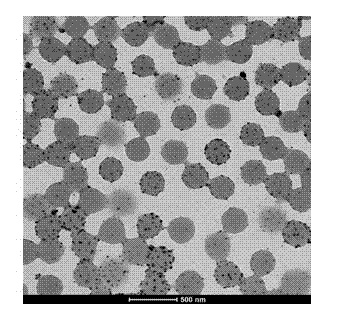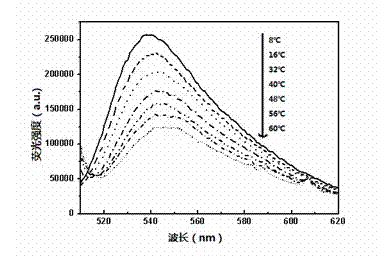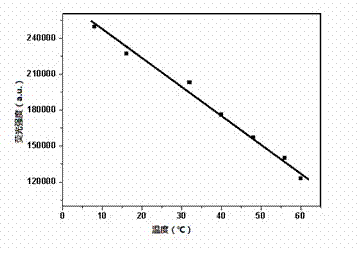Method for preparing bioluminescent nano thermometer
A fluorescent nanometer and thermometer technology, which is applied in the field of nanomaterials, can solve the problems that cannot be realized, and achieve the effect of small size, good biocompatibility and low toxicity
- Summary
- Abstract
- Description
- Claims
- Application Information
AI Technical Summary
Problems solved by technology
Method used
Image
Examples
preparation example Construction
[0022] The preparation method of the bioluminescent nanometer thermometer of the present invention is specifically:
[0023] 1.) Use N-isopropylacrylamide (NIPAM) as a monomer, methylenebisacrylamide (N,N-methylene-bis-acrylamide, BIS) as a crosslinking agent, potassium persulfate ( Potassium persulfate, KPS) was used as the initiator, and Rhodamine 6G (Rhodamine 6G, R6G) was used as the fluorescent active molecule, and the molar ratio of the four was 700:50:15:1~3000:150:40:1. First, NIPAM and BIS Add the mixed aqueous solution of the three-necked flask, then add R6G and mix evenly, and finally add the KPS aqueous solution in the anaerobic environment where the argon gas is continuously passed through the three-necked flask, react in a water bath at 60~80°C for 2~8 hours, and then wash it by centrifugation , remove the supernatant, disperse the remaining product in deionized water, and prepare fluorescent thermosensitive polymer microspheres;
[0024] 2.) Mix the fluorescent...
Embodiment 1
[0028] 1) Preparation of fluorescent thermosensitive polymer microspheres:
[0029] Take 340mg NIPAM and 23mg BIS to make 20ml aqueous solution and put it into a 50ml three-neck flask, then add 0.1ml (0.01mol / L) R6G solution, stir magnetically, and after argon gas for half an hour, quickly add 4ml (0.01mol / L) L) KPS aqueous solution, after reacting in a water bath at 80°C for about 8 hours, centrifuge and wash, remove the supernatant, and disperse the remaining product into 10 ml of deionized water to obtain fluorescent thermosensitive polymer microspheres.
[0030] 2) Preparation of bioluminescence nanothermometer:
[0031] Under the condition of stirring at room temperature, take 2ml of the temperature-sensitive microspheres prepared in the above step 1) into a 30ml three-necked flask, dilute with 8ml of deionized water, add 6ml (0.01mol / L) silver nitrate solution, stir evenly with argon, and deoxygenate with argon , after half an hour, quickly add 1ml of fully cooled (0.01...
Embodiment 2
[0037] 1) Preparation of thermosensitive polymer microspheres:
[0038] Take 80 mg NIPAM and 8 mg BIS to make 20 ml aqueous solution and add it to a 50 ml three-neck flask, then add 0.1 ml (0.01mol / L) R6G solution, stir magnetically, and after argon gas for half an hour, quickly add 1.5 ml (0.01mol / L) / L) KPS aqueous solution, reacted in a water bath at 60°C for about 2 hours, centrifuged and washed, removed the supernatant, and dispersed the remaining product into 10 ml deionized water to obtain fluorescent thermosensitive polymer microspheres.
[0039] 2) Preparation of bioluminescence nanothermometer:
[0040] Under the condition of stirring at room temperature, take 2ml of the fluorescent temperature-sensitive microspheres prepared in the above step 1) and add them to a 30ml three-neck flask, dilute with 8ml of deionized water, add 1ml (0.01mol / L) silver nitrate solution, stir evenly with argon, and deoxygenate with argon After half an hour, quickly add 1ml of sodium boro...
PUM
| Property | Measurement | Unit |
|---|---|---|
| size | aaaaa | aaaaa |
Abstract
Description
Claims
Application Information
 Login to View More
Login to View More - R&D
- Intellectual Property
- Life Sciences
- Materials
- Tech Scout
- Unparalleled Data Quality
- Higher Quality Content
- 60% Fewer Hallucinations
Browse by: Latest US Patents, China's latest patents, Technical Efficacy Thesaurus, Application Domain, Technology Topic, Popular Technical Reports.
© 2025 PatSnap. All rights reserved.Legal|Privacy policy|Modern Slavery Act Transparency Statement|Sitemap|About US| Contact US: help@patsnap.com



